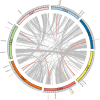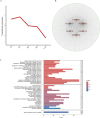Integrating genome and transcriptome-wide data to explore the expression dynamics of TCP genes in Pisum sativum under salt stress
- PMID: 40385237
- PMCID: PMC12083428
- DOI: 10.3389/fpls.2025.1580890
Integrating genome and transcriptome-wide data to explore the expression dynamics of TCP genes in Pisum sativum under salt stress
Abstract
Salt stress severely restricts plant growth and productivity. TCP genes, which are plant-specific transcription factors, play a crucial role in the stress response. However, their functions in pea (Pisum sativum) remain poorly understood. Here, we identified 21 PsTCP genes in pea, classified into Class I (PCF) and Class II (CYC/TB1 and CIN) through phylogenetic analysis. While physicochemical properties varied significantly within the PsTCP family, gene structures and conserved motifs were highly conserved among subfamilies. Comparative homology analysis revealed closer relationships between pea TCP genes and dicots (Arabidopsis) than monocots (rice). Cis-regulatory element analysis suggested roles in growth, hormone response, and stress adaptation. Under salt stress, PsTCP genes exhibited divergent expression patterns, with PsTCP17 showing significant upregulation under extreme stress. Weighted gene co-expression network (WGCNA) and gene ontology (GO) enrichment analyses identified PsTCP20 as a hub gene regulating photosynthesis and metabolic processes. Tissue-specific expression across 11 pea tissues further highlighted their functional diversity. This study provides insights into the molecular mechanisms of salt stress responses in pea and offers genetic resources for breeding salt-tolerant varieties.
Keywords: Pisum sativum; TCP gene family; WGCNA; salt stress; tissue-specific expression.
Copyright © 2025 Fangyuan, Yong, Huang, Zhiyue and Wen.
Conflict of interest statement
The authors declare that the research was conducted in the absence of any commercial or financial relationships that could be construed as a potential conflict of interest.
Figures







Similar articles
-
Genome-wide identification, structural characterization and gene expression analysis of the WRKY transcription factor family in pea (Pisum sativum L.).BMC Plant Biol. 2024 Feb 16;24(1):113. doi: 10.1186/s12870-024-04774-6. BMC Plant Biol. 2024. PMID: 38365619 Free PMC article.
-
Genome-Wide Identification and Expression Analysis of TCP Transcription Factors Responding to Multiple Stresses in Arachis hypogaea L.Int J Mol Sci. 2025 Jan 26;26(3):1069. doi: 10.3390/ijms26031069. Int J Mol Sci. 2025. PMID: 39940846 Free PMC article.
-
Genome-wide identification of oat TCP gene family and expression patterns under abiotic stress.Front Genet. 2025 Feb 4;16:1533562. doi: 10.3389/fgene.2025.1533562. eCollection 2025. Front Genet. 2025. PMID: 39967685 Free PMC article.
-
Omics resources and omics-enabled approaches for achieving high productivity and improved quality in pea (Pisum sativum L.).Theor Appl Genet. 2021 Mar;134(3):755-776. doi: 10.1007/s00122-020-03751-5. Epub 2021 Jan 12. Theor Appl Genet. 2021. PMID: 33433637 Review.
-
Heat stress tolerance in peas (Pisum sativum L.): Current status and way forward.Front Plant Sci. 2023 Jan 17;13:1108276. doi: 10.3389/fpls.2022.1108276. eCollection 2022. Front Plant Sci. 2023. PMID: 36733601 Free PMC article. Review.
Cited by
-
Functional Genomics: From Soybean to Legume.Int J Mol Sci. 2025 Jun 30;26(13):6323. doi: 10.3390/ijms26136323. Int J Mol Sci. 2025. PMID: 40650105 Free PMC article. Review.
References
-
- Amarakoon D., Thavarajah D., Mcphee K., Thavarajah P. (2012). Iron-, zinc-, and magnesium-rich field peas (Pisum sativum L.) with naturally low phytic acid: A potential food-based solution to global micronutrient malnutrition. J. Food Composition Anal. 27, 8–13. doi: 10.1016/j.jfca.2012.05.007 - DOI
-
- Ben Amor N., Jiménez A., Boudabbous M., Sevilla F., Abdelly C. (2020). Chloroplast implication in the tolerance to salinity of the halophyte Cakile maritima . Russian J. Plant Physiol. 67, 507–514. doi: 10.1134/S1021443720030048 - DOI
LinkOut - more resources
Full Text Sources

